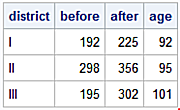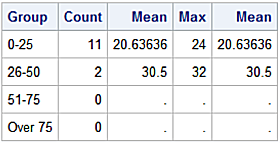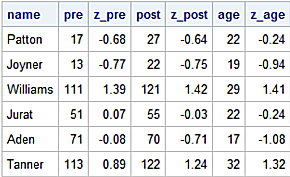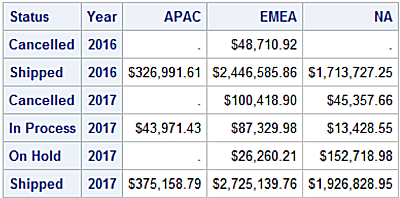GroupBy Object
A pattern common to data analysis is BY-group processing. It is defined as:
• Splitting vales into groups based on some criteria
• Applying a function to the groups
• Combining the results into a data structure
Creating a DataFrame often with a single pass of the data.
The signature for defining a GroupBy object:
DataFrame.groupby(by=None, axis=0, level=None, as_index=True,
sort=True, group_keys=True, squeeze=False, observed=False,
**kwargs)
Create the df DataFrame and GroupBy object for the District column. A DataFrame GroupBy object is returned rather than a DataFrame. The gb object is analagous to a SQL view containing instructions to execute SQL statement to materialize rows and columns when the view is applied.
import pandas as pd
df = pd.DataFrame(
[['I', 'North', 'Patton', 17, 27, 22],
['I', 'South', 'Joyner', 13, 22, 19],
['I', 'East', 'Williams', 111, 121, 29],
['I', 'West', 'Jurat', 51, 55, 22],
['II', 'North', 'Aden', 71, 70, 17],
['II', 'South', 'Tanner', 113, 122, 32],
['II', 'East', 'Jenkins', 99, 99, 24],
['II', 'West', 'Milner', 15, 65, 22],
['III', 'North', 'Chang', 69, 101, 21],
['III', 'South', 'Gupta', 11, 22, 21],
['III', 'East', 'Haskins', 45, 41, 19],
['III', 'West', 'LeMay', 35, 69, 20],
['III', 'West', 'LeMay', 35, 69, 20]],
columns=['District', 'Sector', 'Name', 'Before', 'After', 'Age'])
gb = df.groupby(['District'])
print(gb)
<pandas.core.groupby.generic.DataFrameGroupBy object at 0x000002592A6A3B38>
An approximate SQL analogy.
CREATE VIEW GB as
SELECT distinct District
, sum(Before)
, sum(After)
FROM DF
GROUP BY District
When the GroupBy object is applied results are produced. Create the d_grby_sum DataFrame by adding the numeric columns for each District. All numeric columns in the df Dataframe are grouped by the unique levels of the District column and summed within the group.
d_grby_sum = df.groupby(['District']).sum()
print(d_grby_sum)
Before After Age
District
I 192 225 92
II 298 356 95
III 195 302 101
Examine the d_grby_sum DataFrame index.
print(d_grby_sum.index)
Index(['I', 'II', 'III'], dtype='object', name='District')
The d_grby_sum DataFrame is indexed with values from the District column.
GroupBy objects have attributes allowing examination of their keys and groups. Return the GroupBy keys composed of unique values from the df['District'] column.
gb.groups.keys()
dict_keys(['I', 'II', 'III'])
Return the groups composing the GroupBy object.
print(gb.groups)
{'I': Int64Index([0, 1, 2, 3], dtype='int64'),
'II': Int64Index([4, 5, 6, 7], dtype='int64'),
'III': Int64Index([8, 9, 10, 11, 12], dtype='int64')}
In example above, gb.groups returns a dictionary of key/value pairs. Keys are mapped to a group along with values for rows belonging to that group. Here, rows 0, 1, 2, and 3 define the GroupBy level for District = 'I'.
The SAS analogy.
data df;
infile cards dlm = ',';
length district $ 3
sector $ 5
name $ 8;
input district $
sector $
name $
before
after
age;
list;
datalines;
I, North, Patton, 17, 27, 22
I, South, Joyner, 13, 22, 19
I, East, Williams, 111, 121, 29
I, West, Jurat, 51, 55, 22
II, North, Aden, 71, 70, 17
II, South, Tanner, 113, 122, 32
II, East, Jenkins, 99, 99, 24
II, West, Milner, 15, 65, 22
III, North, Chang, 69, 101, 21
III, South, Gupta, 11, 22, 21
III, East, Haskins, 45, 41, 19
III, West, LeMay, 35, 69, 20
III, West, LeMay, 35, 69, 20
;;;;
proc summary data=df nway;
class district;
var before
after
age;
output out=gb_sum (drop = _TYPE_ _FREQ_)
sum=;
run;
proc print data = gb_sum;
run;
NOTE: There were 13 observations read from the data set WORK.DF.
NOTE: The data set WORK.GB_SUM has 3 observations and 4 variables.

Iteration Over Groups
Iterate over the defined groups.
gb = df.groupby(['District'])
for name, group in gb:
print('Group Name===> ',name)
print(group)
print('='*47)
Group Name===> I
District Sector Name Before After Age
0 I North Patton 17 27 22
1 I South Joyner 13 22 19
2 I East Williams 111 121 29
3 I West Jurat 51 55 22
===============================================
Group Name===> II
District Sector Name Before After Age
4 II North Aden 71 70 17
5 II South Tanner 113 122 32
6 II East Jenkins 99 99 24
7 II West Milner 15 65 22
===============================================
Group Name===> III
District Sector Name Before After Age
8 III North Chang 69 101 21
9 III South Gupta 11 22 21
10 III East Haskins 45 41 19
11 III West LeMay 35 69 20
12 III West LeMay 35 69 20
===============================================
The SAS analog.
proc sort data = df presorted;
by district;
run;
data _null_;
file print;
set df;
by district;
if first.district then
put 'Group Name====> ' district /
'District Sector Name Pre Post Age';
put @1 district @10 sector @20 name
@29 pre @34 post @40 age;
if last.district then
put '=========================================';
run;

Return first row for each group.
df.groupby('District').first()
Sector Name Before After Age
District
I North Patton 17 27 22
II North Aden 71 70 17
III North Chang 69 101 21
Return the last row for each group.
df.groupby('District').last()
Sector Name Before After Age
District
I West Jurat 51 55 22
II West Milner 15 65 22
III West LeMay 35 69 20
GroupBy Summary Statistics
A GroupBy object accepts most methods applicable to a DataFrame, applying methods to groups.
pd.options.display.float_format = '{:,.2f}'.format
gb.describe()
Before After Age
count mean std min 25% 50% 75% max count mean std min 25% 50% 75% max count mean std min 25% 50% 75% max
District
I 4.0 48.0 45.328431 13.0 16.0 34.0 66.0 111.0 4.0 56.25 45.543935 22.0 25.75 41.0 71.50 121.0 4.0 23.00 4.242641 19.0 21.25 22.0 23.75 29.0
II 4.0 74.5 43.339743 15.0 57.0 85.0 102.5 113.0 4.0 89.00 26.620794 65.0 68.75 84.5 104.75 122.0 4.0 23.75 6.238322 17.0 20.75 23.0 26.00 32.0
III 5.0 39.0 20.928450 11.0 35.0 35.0 45.0 69.0 5.0 60.40 30.196026 22.0 41.00 69.0 69.00 101.0 5.0 20.20 0.836660 19.0 20.00 20.0 21.00 21.0
Apply different aggregation methods to columns defined by the GroupBy object.
gb = df.groupby(['District'])
gb.agg({'Age' : 'mean',
'Before' : 'median',
'After' : ['sum', 'median', 'std']
})
Age Before After
mean median sum median std
District
I 23.00 34 225 41.00 45.54
II 23.75 85 356 84.50 26.62
III 20.20 35 302 69.00 30.20
In example above the agg function is applied to the gb GroupBy object with a dictionary identifying differing aggregation methods for the columns. Recall a dictionary is a data structure holding key/value pairs. To perform multiple statistics on a column, pass a list of methods as the values to the dictionary.
The SAS analog.
proc summary data=df nway;
class district;
output out=gb_sum (drop = _TYPE_ _FREQ_)
mean(age) = age_mean
median(before) = bfr_median
sum(after) = aft_sum
median(after) = aft_median
std(after) = aft_std;
run;
proc print data = gb_sum noobs;
run;

Filtering by Group
Filter data based on a group’s statistic. First, display the DataFrame.
print(df)
District Sector Name Before After Age
0 I North Patton 17 27 22
1 I South Joyner 13 22 19
2 I East Williams 111 121 29
3 I West Jurat 51 55 22
4 II North Aden 71 70 17
5 II South Tanner 113 122 32
6 II East Jenkins 99 99 24
7 II West Milner 15 65 22
8 III North Chang 69 101 21
9 III South Gupta 11 22 21
10 III East Haskins 45 41 19
11 III West LeMay 35 69 20
12 III West LeMay 35 69 20
Next, define the std_1 function to slice the rows where the standard deviation for age is less than 5.
def std_1(x):
return x['Age'].std() < 5
Then apply the filter to the df DataFrame grouped by District by chaining the .filter method with the std_1 function as an argument.
df.groupby(['District']).filter(std_1)
District Sector Name Before After Age
0 I North Patton 17 27 22
1 I South Joyner 13 22 19
2 I East Williams 111 121 29
3 I West Jurat 51 55 22
8 III North Chang 69 101 21
9 III South Gupta 11 22 21
10 III East Haskins 45 41 19
11 III West LeMay 35 69 20
12 III West LeMay 35 69 20
GroupBy for Continuous Values
Group by the Age column which has continuous values. Use a dictionary to define the stats function for returning the statistics.
def stats(group):
return {'count' : group.count(),
'min' : group.min(),
'max' : group.max(),
'mean' : group.mean()}
Define the bins object where the first group is 0 - 25, second is 26 - 50 and so on and define the corresponding gp_labels object.
bins = [0, 25, 50, 75, 200]
gp_labels = ['0 to 25', '26 to 50', '51 to 75', 'Over 75']
Assign ‘cut-points’ to the bins object as a list of values for the upper and lower bounds of the bins created with the cut method. Assign these results to the new Age_Fmt column in the df DataFrame.
df['Age_Fmt'] = pd.cut(df['Age'], bins, labels=gp_labels)
Use the apply method with the stats function to apply the statistics to column values for each group. The unstack method reshapes the returned object from a stacked form (in this case a Series to an unstacked form (a “wide” DataFrame).
df['Age'].groupby(df['Age_Fmt']).apply(stats).unstack()
count max mean min
Age_Fmt
0 to 25 11.00 24.00 20.64 17.00
26 to 50 2.00 32.00 30.50 29.00
51 to 75 0.00 nan nan nan
Over 75 0.00 nan nan nan
The SAS analog.
proc format cntlout = groups;
value age_fmt
0 - 25 = '0-25'
26 - 50 = '26-50'
51 - 75 = '51-75'
76 - high = 'Over 75';
proc sql;
select fmt.label label = 'Group'
, count(dat.age) label = 'Count'
, min(dat.age) label = 'Min'
, max(dat.age) label = 'Max'
, mean(dat.age) label = 'Mean'
from groups as fmt
left join df as dat
on fmt.label = put(dat.age, age_fmt.)
group by fmt.label;
quit;

Transform Based on Group Statistic
Up to this point the GroupBy objects return DataFrames with fewer rows than the original. This is expected since GroupBy objects commonly perform aggregations. There are cases where one needs to apply a transformation based on group statistics and merge the transformed version with the original DataFrame.
Consider calculating a z-scores by creating a lambda expression as an anonymous function to compute values for rows within each group using the group’s computed mean and standard deviation.
z = df.groupby('District').transform(lambda x: (x - x.mean()) / x.std())
DataFrames allow the same name for multiple columns. So the rename attribute is applied to the z DataFrame passing a dictionary of key/value pairs where the key is the old column name and the value is the new column name.
Fetch the column names.
print(z.columns)
Index(['Before', 'After', 'Age'], dtype='object')
Rename the columns.
z = z.rename \
(columns = {'Before' : 'Z_Bfr',
'After' : 'Z_Aft',
'Age' : 'Z_Age',
})
Call the concat method to merge the df and z DataFrames. Additional concat examples are in the data managements section of this site.
df1 = pd.concat([df, z], axis=1)
Output decimals two places and display the display the first six rows.
pd.options.display.float_format = '{:,.2f}'.format
print(df1[['Name', 'Before', 'Z_Bfr', 'After', 'Z_Aft', 'Age', 'Z_Age']].head(6))
Name Before Z_Bfr After Z_Aft Age Z_Age
0 Patton 17 -0.68 27 -0.64 22 -0.24
1 Joyner 13 -0.77 22 -0.75 19 -0.94
2 Williams 111 1.39 121 1.42 29 1.41
3 Jurat 51 0.07 55 -0.03 22 -0.24
4 Aden 71 -0.08 70 -0.71 17 -1.08
5 Tanner 113 0.89 122 1.24 32 1.32
The program in a single go.
z = df.groupby('District').transform(lambda x: (x - x.mean()) / x.std())
print(z.columns)
z = z.rename \
(columns = {'Before' : 'Z_Bfr',
'After' : 'Z_Aft',
'Age' : 'Z_Age',
})
df1 = pd.concat([df, z], axis=1)
pd.options.display.float_format = '{:,.2f}'.format
print(df1[['Name', 'Before', 'Z_Bfr', 'After', 'Z_Aft', 'Age', 'Z_Age']].head(6))
Expressed as a SAS program.
proc summary nway data = df;
class district;
var pre
post
age;
output out=z_out (drop = _TYPE_ _FREQ_)
mean(age) = age_mean
mean(pre) = pre_mean
mean(post) = post_mean
std(age) = age_std
std(pre) = pre_std
std(post) = post_std;
run;
proc sort data = df presorted;
by district;
run;
proc sort data = z_out presorted;
by district;
run;
data z_df (drop = age_mean pre_mean post_mean
age_std pre_std post_std);
merge df
z_out;
by district;
z_pre = (pre - pre_mean) / pre_std;
z_post = (post - post_mean) / post_std;
z_age = (age - age_mean) / age_std;
format z_pre z_post z_age 8.2;
run;
proc print data=z_df(obs=6) noobs;
var name
pre
z_pre
post
z_post
age
z_age;
run;

Pivot
pandas provide the pivot_table function to create speadsheet-style pivot tables enabling aggregation of data across row and column dimensions.
Read the input data calling the read_csv method and call the info() function to view column metadata. Multiple examples of the the read_csv method are located in the pandas Readers & Writers section.
import pandas as pd
url = "https://raw.githubusercontent.com/RandyBetancourt/PythonForSASUsers/master/data/Sales_Detail.csv"
df2 = pd.read_csv(url, na_filter = False)
df2.info()
<class 'pandas.core.frame.DataFrame'>
RangeIndex: 2823 entries, 0 to 2822
Data columns (total 10 columns):
OrderNum 2823 non-null int64
Quantity 2823 non-null int64
Amount 2823 non-null float64
Status 2823 non-null object
ProductLine 2823 non-null object
Country 2823 non-null object
Territory 2823 non-null object
SalesAssoc 2823 non-null object
Manager 2823 non-null object
Year 2823 non-null int64
dtypes: float64(1), int64(3), object(6)
memory usage: 220.6+ KB
Call the pivot_table method for the df2 DataFrame, index the Year and ProductLine columns on the rows, index Territory on the columns and aggregate the Amount column.
df2.pivot_table(index = ['Year', 'ProductLine'],
columns = ['Territory'],
values = ['Amount'])
Territory APAC EMEA NA
Year ProductLine
2016 Classic Cars 3,523.60 4,099.44 4,217.20
Motorcycles 3,749.53 3,309.57 3,298.12
Planes 3,067.60 3,214.70 3,018.64
Ships nan 3,189.14 2,827.89
Trains 1,681.35 2,708.73 2,573.10
Trucks 3,681.24 3,709.23 3,778.57
Vintage Cars 2,915.15 2,927.97 3,020.52
2017 Classic Cars 3,649.29 4,062.57 3,996.12
Motorcycles 2,675.38 3,736.90 3,649.07
Planes 2,914.59 3,047.34 3,645.51
Ships 2,079.88 3,030.86 3,067.40
Trains nan 3,344.41 2,924.96
Trucks 3,695.36 4,344.76 3,326.99
Vintage Cars 3,399.04 2,998.96 3,662.24
Notice row labels are formed using the Year column as the outer level and ProductLine as the inner level. Index arguments to the pivot_table function create either an index if one column is specified or a MultiIndex object if multiple columns are specified.
Replace the default aggregation with np.mean aggregation for columns by summing the Quantity column and averaging the Amount column. Call the fill_value argument to replace nan's with 0 (zero). Supply the margins=True argument to get row and column totals.
import numpy as np
pd.pivot_table(df2,values = ['Amount', 'Quantity'],
columns = 'Territory',
index = ['Year', 'ProductLine'],
fill_value = 0,
aggfunc = {'Amount' : np.mean,
'Quantity' : np.sum},
margins=True)
Amount Quantity
Territory APAC EMEA NA All APAC EMEA NA All
Year ProductLine
2016 Classic Cars 3523.597037 4099.436842 4217.195652 4106.951145 842 9152 5673 15667
Motorcycles 3749.530000 3309.571562 3298.123385 3361.024797 683 2265 2105 5053
Planes 3067.596923 3214.703898 3018.643913 3122.067034 419 2106 1582 4107
Ships 0.000000 3189.140541 2827.892187 3080.084434 0 2664 1075 3739
Trains 1681.350000 2708.729167 2573.102727 2638.749444 33 846 409 1288
Trucks 3681.235714 3709.233171 3778.568113 3733.731549 252 2974 1901 5127
Vintage Cars 2915.145625 2927.966544 3020.519333 2965.105660 1022 4523 4300 9845
2017 Classic Cars 3649.291463 4062.572241 3996.115055 4005.964600 1484 10433 6408 18325
Motorcycles 2675.384286 3736.899011 3649.072588 3655.500929 193 3401 3016 6610
Planes 2914.592500 3047.343675 3645.514237 3226.593936 394 4015 2211 6620
Ships 2079.880000 3030.862432 3067.396154 3030.845156 56 2526 1806 4388
Trains 0.000000 3344.409630 2924.959286 3201.182683 0 921 503 1424
Trucks 3695.358077 4344.764828 3326.990533 3758.490314 926 2176 2548 5650
Vintage Cars 3399.041176 2998.955663 3662.238403 3289.029498 1178 5631 4415 11224
All 3376.116878 3556.574365 3586.649339 3553.889072 7482 53633 37952 99067
For the rows examine Status within Year by Territory.
pd.pivot_table(df2,values = ['Amount'],
columns = ['Territory'],
index = ['Year', 'Status'],
fill_value = 0,
aggfunc = (np.sum))
Amount
Territory APAC EMEA NA
Year Status
2016 Cancelled 0.00 48710.92 0.00
Shipped 326991.61 2446585.86 1713727.25
2017 Cancelled 0.00 100418.90 45357.66
In Process 43971.43 87329.98 13428.55
On Hold 0.00 26260.21 152718.98
Shipped 375158.79 2725139.76 1926828.95
SAS analog to produce the same report.
filename git_csv temp;
proc http
url="https://raw.githubusercontent.com/RandyBetancourt/PythonForSASUsers/master/data/Sales_Detail.csv"
method="GET"
out=git_csv;
proc import datafile = git_csv
dbms=csv
out=sales_detail
replace;
run;
proc sort data=sales_detail;
by territory;
run;
proc summary data=sales_detail nway;
by territory;
class year
status;
var amount;
output out=sales_sum (drop = _TYPE_ _FREQ_)
sum(amount) = amount_sum;
run;
proc sort data = sales_sum;
by year status;
run;
proc transpose data = sales_sum
out = sales_trans(drop=_name_);
id territory;
by year status;
run;
proc print data=sales_trans;
var apac
emea
na;
id status
year;
format apac
emea
na dollar13.2;
run;
